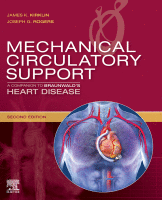Physical Address
304 North Cardinal St.
Dorchester Center, MA 02124

Introduction The evolution of ventricular assist devices (VAD) since the year 2000 has allowed patients with end-stage heart failure to survive with increased functional capacity and quality of life (QOL). Since the beginning of randomized clinical trials in the field,…

Perioperative management This chapter focuses on the early postoperative care of patients with ventricular assist devices (VADs). Appropriate patient selection and optimal implantation techniques greatly simplify postoperative management. Indeed, some problems created by suboptimal implantation techniques are difficult or impossible…

Historical note The first left ventricular assist device (LVAD) was implanted in 1963 by Dr. DeBakey in a patient with postcardiotomy shock. As the incidence of heart failure rose to epidemic proportions, the LVAD emerged as a new solution to…

Development of mechanical circulatory support systems The methods for providing mechanical circulatory support (MCS) have varied greatly. The evolution of MCS technology has been gradual, as the biological barriers to progress have remained constant and difficult. Clinicians and engineers have…

Introduction Heart failure (HF) is one of the major medical burdens in our society. Complete recovery of the heart after insult has been an attractive goal for many clinicians and scientists for long time. Mechanical circulatory support (MCS) devices, such…

Introduction Understanding the hemocompatibility of mechanical circulatory support (MCS) devices requires insight into two scientific disciplines: biology and physics Biology related to MCS is only partially understood and at times seems unpredictable. Mother Nature is responsible for unleashing a variety…

Introduction Mechanical circulatory support with durable left ventricular assist devices (LVADs) has become a mainstay therapy for treatment of advanced heart failure refractory to optimal medical management and has now surpassed cardiac transplantation as the most frequently utilized surgical therapy…

Background The modern era of extracorporeal circulation began in the early 1950s, with cardiopulmonary bypass (CPB) used to support patients during open-heart operations for the repair of congenital heart defects. Over the course of the next two decades, improvements to…

Introduction Cardiogenic shock (CS) is a state of insufficient cardiac output and end-organ perfusion that can be the terminal phase of many different cardiac conditions, including acute coronary syndromes, arrhythmias, progression of chronic cardiomyopathy, and acute cardiac dysfunction in the…

Introduction Deciding who should and who should not proceed with mechanical circulatory support (MCS)—including timing and device type—is one of the most difficult challenges in medicine. While there are now over 6 million people in the United States with heart…